Good boots are a hiker’s best friend: They help carry the load, lead us to beautiful places, navigate us across rivers and up mountains, and are there while we make outdoor adventure memories. Choosing the best pair is like finding the right trail partner: You’ll want to make sure you are comfortable together, move in sync and are prepared to tackle whatever comes your way.
Shopping for the perfect hiking boots can be overwhelming: There are so many to choose from, each with its own complicated specifications and features. That’s why our dedicated REI Co-op Member testers spent months wearing and trekking in dozens of pairs over hundreds of miles to see how well they perform. We believe these seven hiking boots strike the balance of comfort, durability, support, weight and value, putting them at the top of our list.
Looking for something a little lighter and lower-cut for your trail time? See our Best Hiking Shoes of 2025: Staff Picks guide for our favorites in that category.
The 8 Best Hiking Boots of 2025: Test Results
Find our quick recommendations here or read on for the full reviews.
Jump to Buying Advice and Methodology.
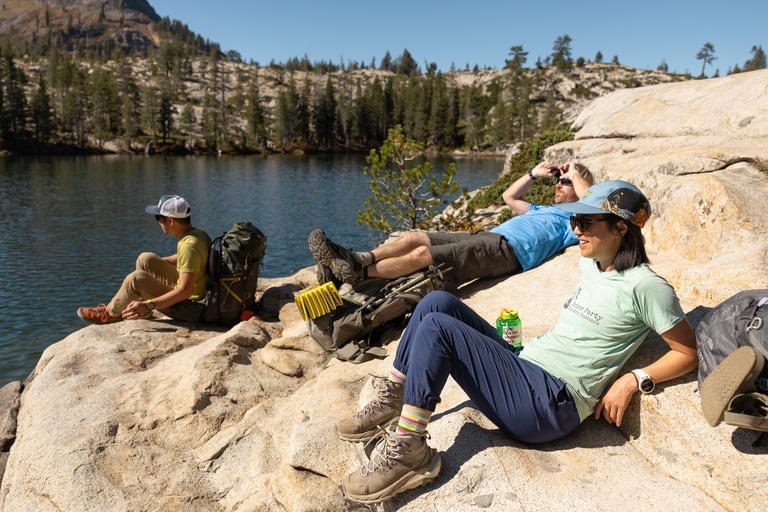


Altra Lone Peak 9 Waterproof Mid Hiking Boots
Score 90
Waterproof Yes
Waterproofing Waterproof bootie construction
Upper Recycled polyester mesh
Weight (pair) 1 lb. 11 oz. (women’s), 1 lb. 13.7 oz. (men’s)
Best for Hiking, backpacking, thru-hiking
Even barefoot-shoe diehards need a little something extra sometimes. The zero-drop Lone Peak 9 Waterproof Mid Hiking Boots from Altra are our choice for minimalist hikers whose treks call for more underfoot support and structure.
A 5-millimeter footbed and 25-millimeter stack height and updated, lighter-weight foam midsoles offer moderate spring and cushion without compromising on the barefoot benefits: a natural gait and ground connection. Toes can splay comfortably in the generous toe box, boosting balance and traction. (Note: If you’re not already used to hiking in barefoot or zero-drop shoes, you’ll want to slowly acclimate to them. Read Minimalist/Barefoot Running Basics for more information about adjusting to zero-drop shoes.)
Molded heel cuffs cradle the Achilles and keep your foot from slipping forward in the shoe, though testers more accustomed to wearing trail runners found the extra contact points hard to get used to. One experienced thru-hiking tester from Idaho experienced abrasions on her inner ankle bones from the collar until she laced up a different way. The recycled polyester mesh uppers feature a nonfluorinated waterproof membrane, and built-in gaiter attachment loops let you add more protection from weather and debris without having a bulky strap underfoot.
Testers were also impressed by the tread on a variety of terrain: The MaxTrac™ rubber outsoles held tight to gravel, sand, leaves, rocky inclines, waterfall-wet mud and heavy snow. One tester wore them in Kentucky’s Red River Gorge and loved the “amazing grip” on trails even after a heavy rainstorm. “I found that the tread really helped me stay confident in my footing and was honestly one of the better-traction hiking boots I’ve ever worn,” she says. While they’re not the lightest boots on this list, our field testers felt like they could be fast and nimble in the Lone Peaks. “I prefer this type of boot for the hiking I do because I feel like I can accomplish more rock scrambling and technical hikes and am not weighed down by the boot itself,” one says.
Durability is a notorious weak point for previous Lone Peaks, but our testers reported being pleasantly surprised at how well the 9s held up over several weeks of hard wear. One tester says she had to have a previous pair restitched after a couple weeks, but these have “held up nicely!” Buy women’s. Buy men’s.
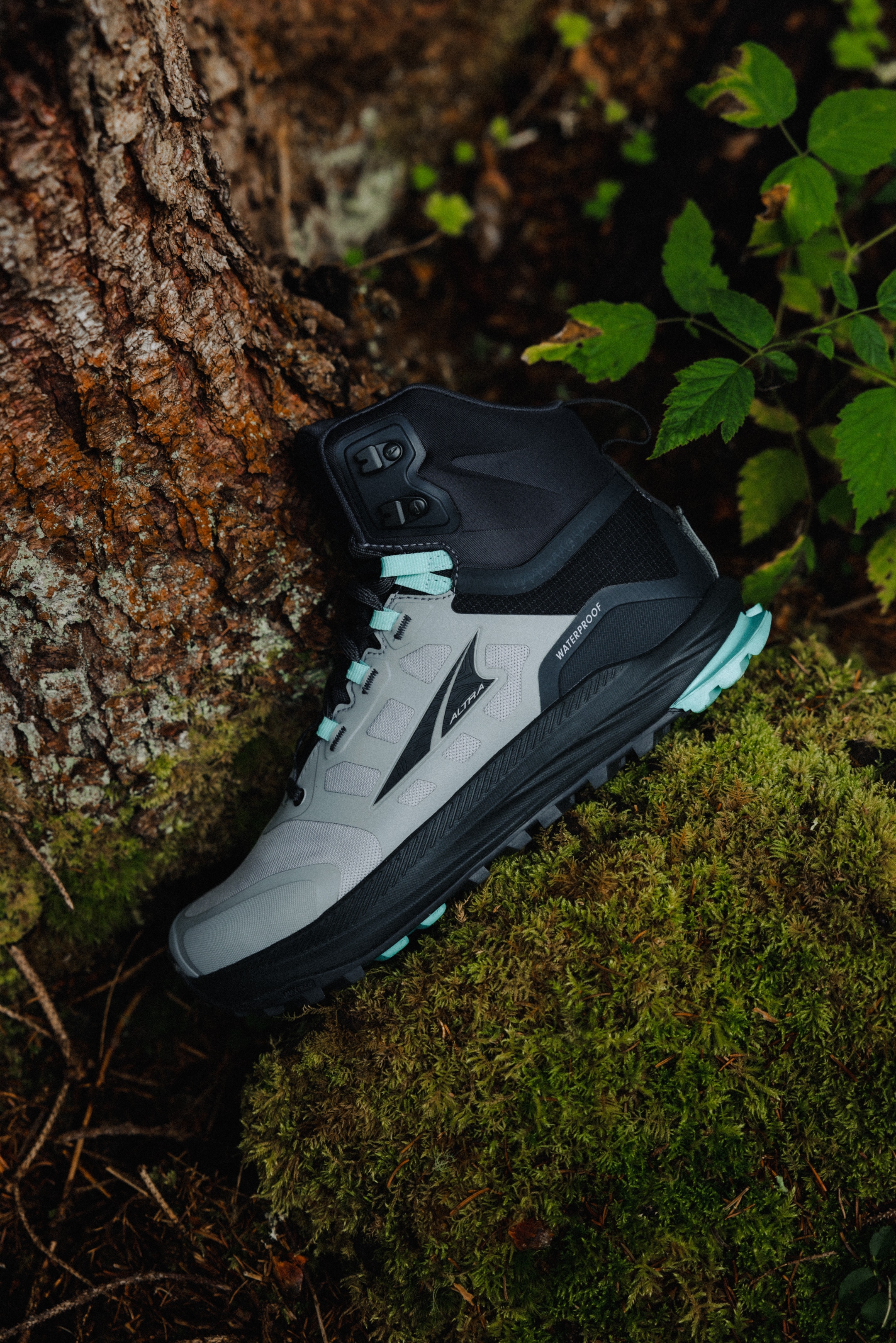
Bottom Line: The lightweight, zero-drop Altra Lone Peak 9 Waterproof Mid Hiking Boots offer barefoot-shoe lovers more support and structure on the trail.
Testing Stats:
- Total distance hiked: 46 miles
- Testing states: Idaho, Kentucky, Wyoming
- Best testing story: One Altra-loyal tester wore her previous pair of waterproof Lone Peak mid boots while trekking in the Himalayas, swapping her Lone Peak trail runners for them any time there was snow or extremely rocky moraine. After testing, she was so impressed with the latest version that she immediately bought an extra pair to have on hand.
Danner Mountain 600 Leaf GTX Hiking Boots
Score 93
Waterproof Yes
Waterproofing GORE-TEX 2-layer waterproof/breathable laminate
Upper material Full-grain leather
Weight (pair) 2 lbs. (women's), 2 lbs. 4 oz. (men's)
Best for Hiking
The Mountain 600 Leaf GORE-TEX Hiking Boots from Danner are a hiker's soulmate—and beyond being sturdy, stable and stylish, they can also be resoled. In fact, they are eligible for full Recrafting services, a testament to the shoe brand's pledge to the environment. Instead of chucking your hiking boots when the soles are too worn to wear, ship them back to the factory in Portland, Oregon. There, the Danner Recrafting team will assess your pair and can slap on a fresh sole before shipping it back to you for plenty more trail time. (Other Recraft services include leather care and reworking, restitching, parts replacement and more.)
Of course, the shoe has to work well if you want to wear it for years. The Mountain 600 Leaf GTX is one of our favorites for burly traction and protection on rugged terrain. Thanks to Vibram® rubber outsoles with Megagrip (the stickiest out there), the boots held fast on gritty sandstone and slick mud. "My wife slid downhill for one of the super slippery sections, but I had enough traction that I could pull her up with me," reports one tester after a weekend hike in Colorado's Holy Cross Wilderness.
Full-grain leather isn't naturally waterproof, but thanks to a two-layer GORE-TEX, it would take a monsoon to bust through the Mountain 600 Leaf GTX. "I flopped into an ankle-deep mud hole and my feet still stayed dry," reports our crew in Iowa. And, the Vibram® EVA midsole is soft enough for immediate comfort but still provides enough support that you won't struggle under heavy backpacks. All this durability comes with a weight penalty though; these definitely feel heavier than others on the list. Buy women's. Buy men's.
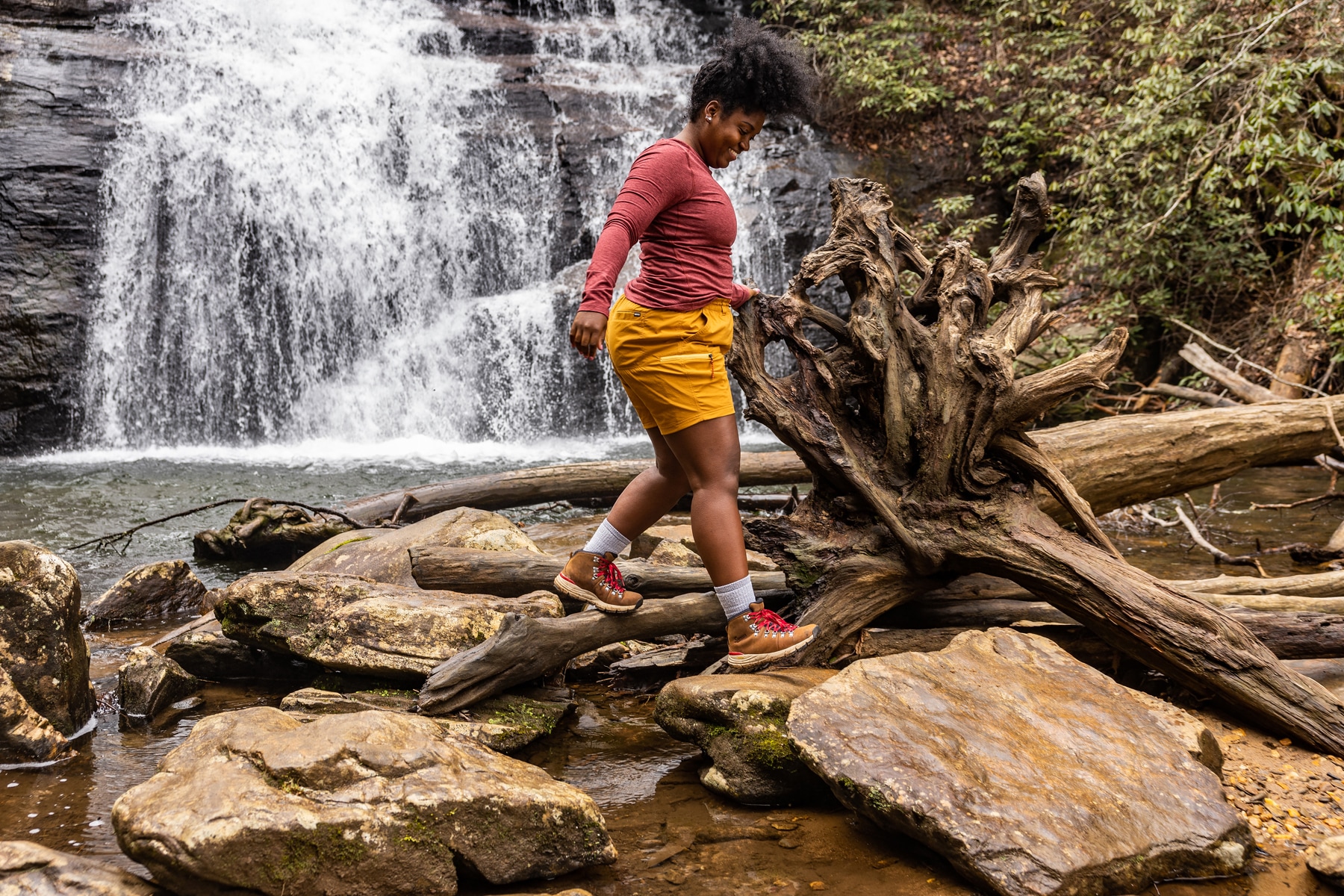
Bottom Line: Hardworking leather uppers and a cushioned ride are the secret behind the Danner Mountain 600 Leaf GORE-TEX boots, the most traditional pair of hikers on the list.
Testing Stats:
- Total distance hiked: 49 miles
- Testing states: Colorado, Iowa, Michigan
- Best testing story: One tester in Colorado admits to wearing his hiking boots as daily drivers because he loves them so much. "I've even been wearing them to work and to pick up our kid from school," he reports. "They're so comfortable out of the box."
HOKA Kaha 3 GTX Hiking Boots
Score 89
Waterproof Yes
Waterproofing Leather Working Group Gold-rated waterproof nubuck leather
Upper Leather and GORE-TEX Invisible Fit footwear fabric with 71% recycled polyester face (main); 100% recycled polyester mesh (quarter/tongue/lining)
Weight (pair) 2 lbs. 1.6 oz. (women’s), 2 lbs. 9.8 oz. (men’s)
Best for Hiking
While HOKA might be best-known for cushy, chunky-heeled running shoes, the brand has made strides in hiking footwear as well. The Kaha 3 GTX boot is its first mid-cut hiker using GORE-TEX Invisible Fit lightweight. This waterproof and windproof fabric is engineered for to be more flexible and weigh less than what's found in more traditional GTX hiking boots.
That said, no one would call the Kaha 3 “light” at more than 2 pounds per pair, though most of its bulk is in the heel and midsole—and testers say the comfort’s worth it. Bouncy, dual-density midsoles made with 30% sugarcane EVA minimize impact strain on joints, and the Kaha 3’s forked, extended heels are designed to absorb impact and allow the foot to adjust on uneven terrain. Testers who normally find their heels shifting in their boots say the HOKAs held them snugly but comfortably. A grooved MetaRocker™ underfoot boosts propulsion on the trail and uphill with rolling heel-to-toe action that improves speed and stability. “The only thing keeping me from giving these boots a perfect rating for comfort was their width,” says a tester who found them “a smidge too narrow in the toe box—but every other aspect of them was perfection.”
Grippy Vibram® Megagrip outsoles with 4-millimeter lugs are specifically designed for loose and rocky terrain in both wet and dry conditions. Our Pennsylvania tester found that even without traction devices, his HOKAs handled snow, ice and mud “like a pro” though he was initially skeptical. “Once I was a few miles in, I was totally confident in my steps,” he says.
Hikers looking for more support and stability on uneven terrain appreciate the higher collar’s extra padding and protection. “The HOKAs cradled my heel and ankle like a glove—a very comfortable glove,” says our Pennsylvania tester. “There wasn't even a hint of an ankle wobble over slippery and stumpy terrain.” Despite its height, the collar provides the boot with a sleek silhouette that’s ready to hit the street, making this one of the most versatile trail-to-town options here.
The Kaha 3 is the priciest boot on the list, but testers say it’s worth the investment if you’re in the market for a stylish day hiker that will have you bouncing down the trail with a smile. Buy women’s. Buy men’s.
Bottom Line: Hikers looking for cushion on the trail and style around town: HOKA Kaha 3 GTX Hiking Boots are for you.
Testing Stats:
- Total distance hiked: 43
- Testing states: New York, Pennsylvania
- Best testing story: For some testers, it's the little things that matter most. In this case, shoelaces: "One major win on these boots are the shoelaces … yes, the shoelaces. They have a bit of a 'wave' to them—meaning they are not perfectly round—and that made a HUGE difference. In many other boots, if I don't double knot them, they are untied in a mile or two. I intentionally left my HOKAs with a single knot and I didn't even have any loosening of the laces over a few hours on my hike."


Lowa Renegade Evo GTX Mid Hiking Boots
Score 96
Waterproof Yes
Waterproofing GORE-TEX waterproof/breathable membrane
Upper Nubuck leather
Weight (pair) 2 lbs. 8 oz. (women’s), 2 lbs. 9.6 oz. (men’s)
Best for Hiking, backpacking
Since 1997, the Renegade line of Lowa hiking boots has been a co-op bestseller because of its lightweight flexibility, durability and unbeatable performance under heavy loads. In other words, there’s a reason the Renegade has had an REI Co-op Editors’ Choice Award since 2021. The newly updated Renegade Evo leaves much of the classic design intact, but there are some fine-tuned features that warranted a fresh round of field testing.
Starting from the bottom, the Renegade Evos get a whole new sole: Both the mid- and outsole are renovated for a more supportive, more comfortable and grippier boot. Lowa reformulated the boot's double-injection polyurethane midsoles to be firmer while still offering superior impact absorption, and new Vibram® Rene Trac outsoles with wider, multidirectional lugs make for better sticking and stopping. (Earlier Renegades had closer-set and more uniform lugs.) “The tread design is impressive,” says one tester who wore them on a partial hike of the Continental Divide Trail. “[The boot] grips trail surfaces at the toe and rocks your foot forward into the next step, [so it's] easy to cover uneven ground without much effort.” That same tester says the Renegade Evos have great downhill traction and stay planted in snowy and icy conditions. Another tester wore hers on a steep hiking trail down Mount Si outside Seattle. “I had a firm grip all the way down. No slips! Great traction,” she shares. A PU wrap cups the heel snugly, and ankles stay put thanks to a sturdy but generously padded collar. “Boots are very stable side to side, with good ankle support while scrambling through brush and stepping onto rocks and logs. No tendency to roll over sideways,” reports a tester in New Mexico.
Nubuck leather with a GORE-TEX waterproof/breathable membrane makes these kicks a dry fortress, and the refreshed uppers have fewer seams, meaning fewer pressure points and reduced wear. Testers loved them right out of the box on longer day hikes. The women’s version was set on a last specifically designed for the female foot for a superior fit. Buy women’s. Buy men’s.
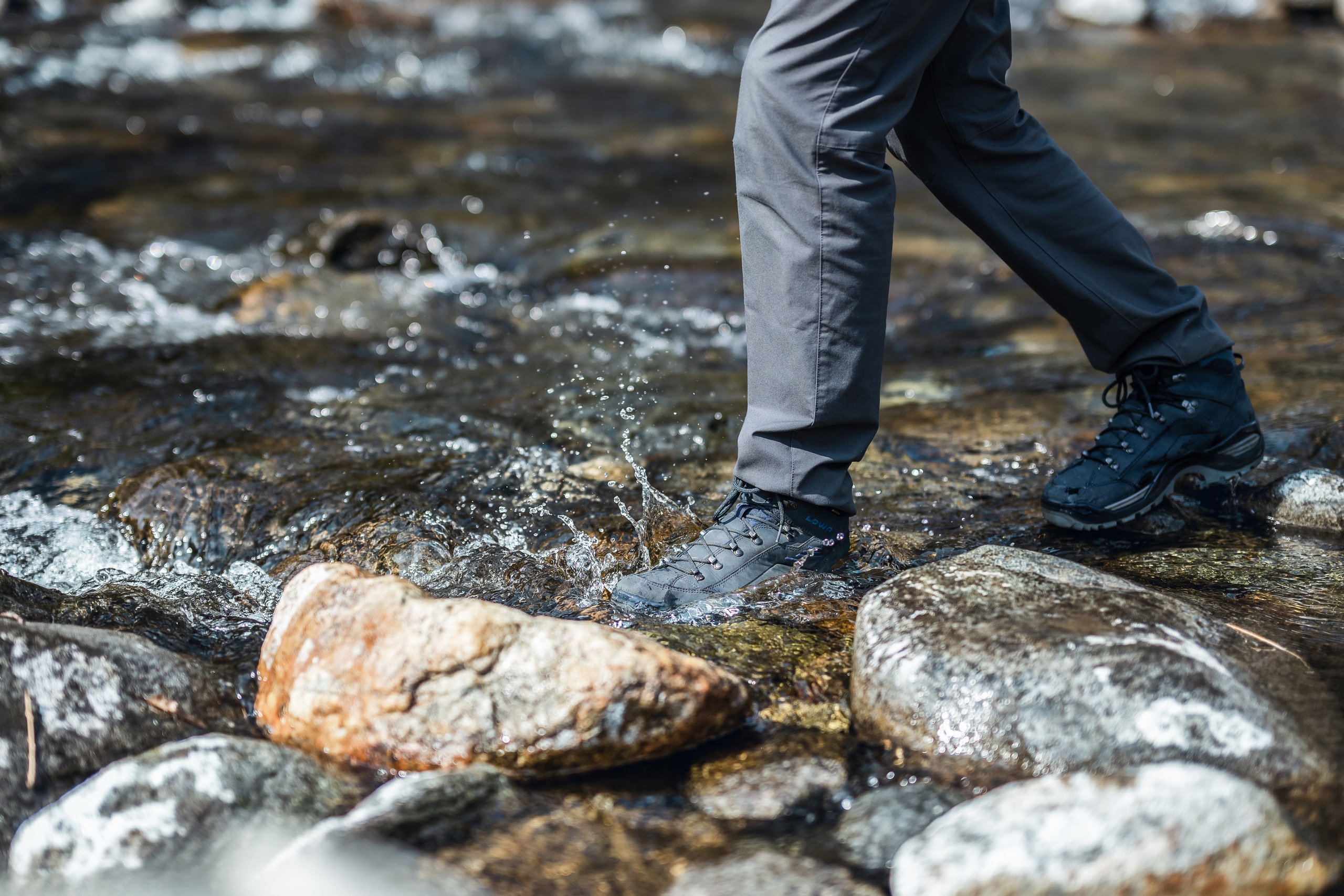
Bottom Line: Take to the trail with confidence thanks to the superior tread, underfoot support and overall comfort of the Lowa Renegade Evo Hiking GTX Mid Hiking Boots.
Testing Stats:
- Total distance hiked: 50 miles
- Testing states: Colorado, New Mexico, Washington
- Best testing story: Our Washington state tester is especially invested in boots with comfortable ankle support. “A couple years ago, I developed blisters on the backs of both of my ankles thanks to a combination of ill-fitting hiking shoes and the sediment that became lodged in them. Those blisters later became severely infected, landing me in the ER. Needless to say, I really appreciate a boot that doesn't rub, and this model did not disappoint.”
Merrell Moab Speed 2 Mid GTX Hiking Boots
Score 96
Waterproof Yes
Waterproofing GORE-TEX waterproof membrane
Upper Nylon ripstop/TPU
Weight (pair) 1 lb. 8.7 oz. (women’s), 1 lbs. 12.2 oz. (men’s)
Best for Hiking, backpacking
These boots summited Mount Kilimanjaro. Seriously—one of our testers wore a pair of Merrell Moab Speed 2 Mids for more than 100 miles over eight days through mud, rocks, snow and rain to reach 19,340 feet above sea level. If that’s not enough to convince you they’re worthy of this list, how about this: The Moab collection of Merrell shoes and boots has been going strong since 1982 and is designed for superior comfort and durability no matter how far (or how high up) you’re taking them.
The heart of the Moab is in its outsole: a Vibram® TC5+ rubber compound specifically formulated for Merrell, with 4-millimeter traction lugs designed to slough mud and debris as you walk. Full-length rock plates shield feet from sharp stones or rocks and add stability. A heel counter keeps your foot placed properly, though our Kilimanjaro-hiking tester says descents in her Moabs were especially hard on one of her big toes “to the point that it bruised.” (To be fair, not everyone descends 6,000 feet in one day.) Designed for maximum comfort and agility, the Moabs’ cushy FloatPro™ foam midsoles and padded ankle collars hit that just-right balance of softness and structure. The tongues are gusseted to the upper to help keep rocks and dirt out of your boots, and a GORE-TEX waterproof/breathable membrane does the same for water and weather.
Significantly, the Moab Speed 2 Mids don’t compromise on durability just because they’re lightweight: Vegan-friendly nylon ripstop and TPU uppers stood up everything testers threw at them, whether they were scaling peaks in Tanzania or tackling steep trail steps and rocky switchbacks hiking to Washington’s Bridal Veil Falls and Lake Serene. (They’re also available with leather uppers in women’s and men’s.) A synthetic heel and toe cap further protect against abrasions. “I did not know it was possible for boots this light to be as durable and heavy duty as some of the more classical mid-sized hiking boots,” says one tester who strapped on traction devices for a 9-mile trek on a frozen-solid rocky, snow-covered trail. “They did not feel that flimsy at all.” Buy women’s. Buy men’s.
Bottom Line: The Merrell Moab Speed 2 Mid GTX Hiking Boots offer comfort and durability for the long haul, whether you're hiking near home or scaling Kilimanjaro.
Testing Stats:
- Total distance hiked: 155 miles
- Testing locations: Minnesota, Washington, Wisconsin; Tanzania
- Best testing story: “I donated these boots after my climb to the women porters that work on Mount Kilimanjaro,” said our mountaineering tester. “There aren't many women on that mountain doing the kind of work they do, and it felt good to leave them with some quality gear. They were happy to receive these boots and stated they will use them well.”

Oboz Ousel Mid Waterproof Hiking Boots - Women's
Score 85
Waterproof Yes
Waterproofing Single-layer B-DRY waterproof membrane
Upper Nubuck leather/mesh
Weight (pair) 1 lb. 12.2 oz.
Best for Hiking, backpacking
Day hikers and chill overnighters, the Ousel Mid Waterproof Hiking Boots from Oboz are for you. With supple nubuck leather uppers and proprietary Trail Tread™ rubber outsoles with medium-depth lugs, this traditional mid boot is ready to take on groomed but rocky trails and haul moderate loads. Field testers wore them on day treks and short-term backpacking outings that took them through deep sand, over slick surfaces, in heavy leaf litter, on waterfall-wet rocks and on steep scree—and unanimously praised how their kicks still looked as good as new afterward.
“After 20 to 25 miles in them, I notice almost no wear on the outsole, including on the toe guard—and these are the parts of the shoe I would most expect to get beaten up,” says one tester in Colorado. “The midsole shows some dirt and a few dings, but that just makes it a respectable, worn shoe with a few battle scars. Likewise, the shoe’s nubuck leather upper and the laces are in great shape with no visible wear. The leather in particular lives up to its billing as ‘abrasion-resistant.’”
The 100% recyclable B-DRY (or “breathable dry”) waterproof membrane keeps water out while allowing sweat to evaporate, and our Kentucky tester reports that her socks stayed bone dry even after several creek crossings. Single-density Swiftcurrent EVA midsoles are specifically designed for a woman’s foot to provide lightweight, durable comfort that absorbs impact and provides arch support. One tester who hiked 12 miles in deep sand says, “These boots felt great on my arches. I was very pleased with how my feet felt after.” Other testers feel the sizing runs a bit small on the Ousels, and our Kentucky tester recommends going up a half-size to avoid feeling cramped in the toe box. The collar received mixed feedback as well: While some say their ankle felt snug and secure, our Colorado tester found she couldn’t get the collar tight enough for her liking. “The two dual hooked eyelets made it difficult to cinch the boot down firmly around my ankle, where I really need the support. The eyelets simply hold the lace too tight to allow cinching where I need it,” she says. “On the other hand, the solid outsole meant I wasn’t too leery of spraining [or] rolling an ankle.”
Falling in the Goldilocks range weight-wise, the Ousels are, as one tester said, the boots to pick up when you need a solid base underfoot and boots you can count on for steadiness under a gear haul. “Just a workhorse that the user can rely on,” she says. Buy here.
Bottom Line: Designed specifically for a woman's foot, the Oboz Ousel Mid Waterproof Hiking Boots are workhorses both on day hikes and overnights.
Testing Stats:
- Total distance hiked: 57 miles
- Testing states: Colorado, Illinois, Kentucky
- Best testing story: Our Illinois tester found her hike interrupted several times for good reason: People wanted to know where she got her boots. “I have never received as many compliments on a pair of boots as I have these. I received the Port colorway and people went crazy over them. I got asked many times what boots they were. Fashionable and comfortable.”


On Cloudrock Mid Waterproof Hiking Boots
Score 97
Waterproof Yes
Waterproofing Cosmo waterproof membrane
Upper 100% recycled polyester
Weight (pair) 1 lb. 11.4 oz. (women’s), 1 lb. 11.5 oz. (men’s)
Best for Hiking
“There's a reason people say wearing On shoes feels like walking on a cloud: These might actually be the most comfortable boots I've ever worn,” says one Minnesota tester after several weeks in the field. Proprietary CloudTec technology helps create this floating-on-the-trail sensation: Those cylindrical pods at the boots’ foundation compress vertically and horizontally as you move, absorbing impact and rebounding faster with less joint strain. A combination of plush, proprietary “superfoam” midsoles and a nylon Speedboard® plate connecting the heel and forefoot encourage forward motion and build momentum as you move.
Our Kentucky tester cites comfort as the most impressive aspect of the Cloudrocks: “From the instant I put them on, I felt comfortable in them. They stayed comfortable on hills, through creeks and just sitting in the car on the ride home.” Another tester says the Cloudrocks “ride like a sneaker,” lightweight and agile enough to become an everyday shoe.
OK, so they feel good on the foot: But can they perform? Our testers say yes: According to our Kentucky tester, the boots stood up to a variety of terrains, and she sailed through creek crossings easier than her trail crew because she felt so stable traversing the wet rocks. Another tester praised the specially formulated rubber-compound Mission Grip™ outsoles’ stickiness and the wider-set, shallower lugs that help the boots stay planted on various terrain. “I had no problem scrambling uphill, stabilizing myself on downhills or crossing ice. [The Cloudrocks] even held fast on a slick stone trail staircase down by the Mississippi River gorge,” they say.
Padded collars brace and stabilize ankles and keep out rocks and debris, though one tester opted to wear gaiters for extra protection in very deep snow. When all that snow melted, the same tester was able to see how waterproof the boots are: “We had a tremendous rainstorm that melted all the existing snow and fully flooded our backyard one day. I found myself wading through an actual pond to get to the car, a good three inches deep, and my feet were still bone dry inside the Cloudrocks.”
Testers did balk a little at the higher price point (these are the second-most expensive boots on the list), noting that they’ve been burned before by paying more for style and finding the substance lacking. One said his hesitation comes from On having relatively less experience with hiking footwear than, say, Merrell or Lowa. Buy women's. Buy men's.
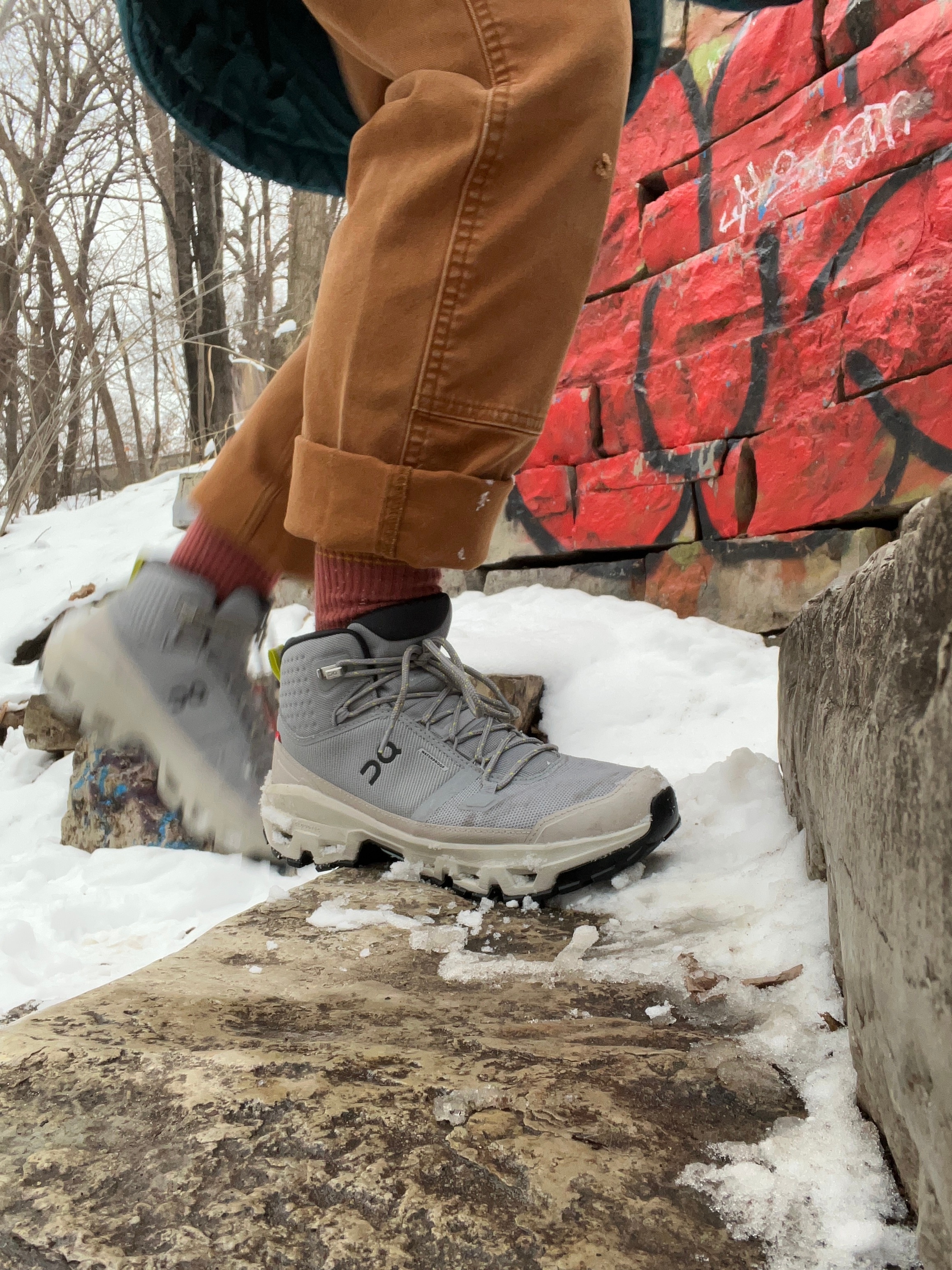
Bottom Line: For top-notch trail durability and support that wears like a sneaker, the On Cloudrock Mid Waterproof Hiking Boots deliver.
Testing Stats:
- Total distance hiked: 85 miles
- Testing states: Kentucky, Minnesota
- Best testing story: “I volunteer for an organization that helps people find their lost dogs, and sometimes I act as ground support on searches. I laced up the Cloudrocks and went out to check every stream, pond, window well and alley I could find in a 5-mile radius while on the hunt for a missing senior dog named Henry. I finished the day with a long walk around the perimeter of a snow-blanketed golf course (dogs love hiding in golf courses), where I crawled through a hole in the fence, crab-walked myself under a deck and went shoulders-deep into a culvert looking for dog tracks. By the end, I had holes in my jacket (where I got caught on said fence) and my gloves were soaked through, but my feet were dry—and I found what were likely his tracks, which gave the family hope.”
Salomon X Ultra 5 Mid GORE-TEX Hiking Boots
Score 96
Waterproof Yes
Waterproofing GORE-TEX
Upper Synthetic/textile
Weight (pair) 1 lb. 11.4 oz. (women’s), 1 lb. 15 oz. (men’s)
Best for Hiking
If you’re looking for a boot that encourages you to surge, jump, ricochet and occasionally shout, “Parkour!” while on a hike, the updated X Ultra 5 Mid GORE-TEX Hiking Boot from Salomon is for you. Designed for ultimate trail agility while keeping you steady on your feet, this durable, lightweight boot is a worthy successor to the X Ultra series, which has been a best-seller since it debuted in 2012.
Their bombproof synthetic/textile uppers of woven nylon and Kevlar® faced off with rocks, branches, dirt, muddy rainforest trails, sand, ocean water and steep oceanside boulder scrambles in our tests and never looked the worse for wear. “After 25+ miles in various conditions, they’re like new,” according to one Maine-based tester who says mud washed right off and ice and snow didn’t cause any discoloration. “can’t even tell they’re not fresh out of the box.” Despite the armor-like protection, the X Ultra 5s are lightweight and flexible enough for speed.
Traction is the X Ultra 5’s other main selling point: Proprietary All-Terrain Contragrip® outsoles combine a specialized rubber compound and dialed-in lug pattern that’s ready for muddy, slippery, rocky and uneven terrain. Pronounced, angular lugs sink into soft surfaces like sand, snow and mud; their close-set design provides more sticky surface area that can handle wet and slick environments. “I wouldn’t hesitate to wear them in any terrain. Incredible grip on wet granite, the tread does a great job of shedding mud and dirt while walking,” says one tester who wore these on muddy, damp hikes through the rain forest in Puerto Rico. Our Minnesota-based tester trudged through deep snow and ice without missing a step. “My dog is a puller on walks, and when I’m wearing lesser shoes, we may as well be skijoring. With these, though, I was able to stay safely planted even over black ice and on a frozen lake.”
As for comfort, these hiking boots don’t slouch either. “What a dream to hike in,” said our rainforest-hiking tester who “did a 6-plus mile trek with a 40-pound toddler in a hiking pack.” Not only didn’t he worry about rolling an ankle, he also says the shoes helped him be nimble and “run, jump and hike for hours in comfort just out of the box.” Our Kentucky tester echoes the zero-break-in requirement: “Immediately upon putting on the shoes I felt cushioned and padded in the right spots. I have previously tried hiking boots that have blistered the back of my ankle, but these felt equally sturdy and cushioned.” Responsive EVA midsoles absorb impact even on fast-moving hikes, and while a TPU plate adds structure and durability, long-distance-lovers might notice that compression changes the ride over time. A heavily padded tongue provides cushioned protection at the ankle joint, though one tester found it a bit too bulky: “I couldn’t tie the laces tight enough at the top because the tongue is so plush,” they say. “As a result, they ended up feeling a little looser around the collar, which slowed me down a little going over more complicated obstacles.” Also available in a low-cut hiking shoe version in women’s and men’s and a GORE-TEX hiking shoe in women's. Buy women’s. Buy men’s.

Bottom Line: The Salomon X Ultra Mid GORE-TEX Hiking Boot strikes a balance between burly protection and nimbleness for longer day hikes, fast miles on varied terrain and lighter-haul overnights.
Testing Stats:
- Total distance hiked: 164 miles
- Testing locations: California, Kentucky, Maine, Minnesota, New Hampshire, Puerto Rico
- Best testing story: “I took these to Puerto Rico, hiking in 90% humidity. I knew the GTX membrane would be hot—and it was! To counteract, I wore a thin pair of Paca hiking socks, which worked great. I was able to take off for a mid-hike river swim, which also helped. Meanwhile, in below-freezing Maine winter weather, they were also hot with a thick Smartwool sock, but it was much appreciated. And the color is super cool as well, which is always a plus.”
Buying Advice
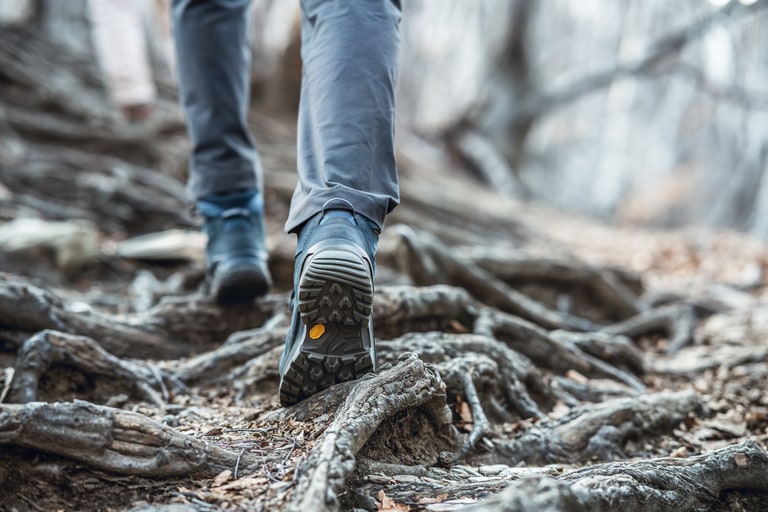
There are a few important components to consider when you're buying a boot. You'll want to know what the uppers, midsoles and outsoles are made of before you choose your pair.
Hiking Boot Uppers
A boot is typically constructed with synthetic or leather materials. Synthetic materials like polyester or nylon breathe well and weigh less, but they don't have the same longevity as leather. On the other hand, many backpacking boots still use leather (often nubuck) for added durability and support. Leather also tends to mold to your foot after long-term use, giving you a sort of customized boot.
In this gear guide, we recommend hiking boots with both synthetic and leather options, as well as a couple of hybrids. The leather options are the Danner Mountain 600 Leaf, Lowa Renegade Evo GTX Mid and Oboz Ousel. (The Merrell Moab Speed 2 Mid GTX is also available with leather uppers.) The synthetic options are the Altra Lone Peak 9 Waterproof, Merrell Moab Speed 2 Mid GTX, On Cloudrock Mid Waterproof and Salomon X Ultra 5. One pair of hiking boots is considered hybrid, meaning it combines leather and synthetic materials to draw the benefits from each. The hybrid option in this guide is the HOKA Kaha 3 Mid GTX.
It's important to note that the upper itself isn't what's waterproof. If a hiking boot is waterproof, it either has a socklike waterproof bootie inside or, more likely, an invisible-to-you waterproof membrane or liner beneath the upper. That additional layer can make a boot significantly less breathable (and more expensive), so it may be unnecessary if you don't hike in wet climates or plan to push your boots into winter use. Every boot on this list is waterproof.
Hiking Boot Midsoles
Between a boot's insole and outsole is—you guessed it—a midsole. The midsole provides cushioning and support and absorbs shock. It's typically constructed of one of two materials: EVA or PU. EVA (or ethylene vinyl acetate) is a softer foam, so it feels comfy underfoot. That softness, though, means it doesn't have the same durability as a firmer material. PU (or polyurethane) tends to be less comfortable out of the box, but it provides more support and rebound under heavy loads and lasts longer over time.
This year, we reviewed boots with both EVA and PU midsoles. The boots with EVA midsoles are the Altra Lone Peak 9 Waterproof, HOKA Kaha 3 Mid GTX, Merrell Moab Speed 2 Mid GTX, Oboz Ousel Mid Waterproof, On Cloudrock Mid Waterproof and Salomon X Ultra 5. The Danner Mountain 600 Leaf features a rubberized EVA midsole, which is more durable than traditional EVA. The option with PU midsoles is the Lowa Renegade Evo GTX Mid.
If a hiking boot has a shank or rock plate, that rigid piece of plastic sits underneath the midsole. These plates will make a boot stiffer, both heel to toe and side to side. A stiff boot like this tends to be best for mountainous or steep terrain, where you can save energy by not overflexing your boot. This additional layer may also be strategically placed under the ball of your foot to protect from rock bruising. The Merrell Moab Speed 2 Mid GTX features a full-length rock plate.
Hiking Boot Outsoles
Whether you're hiking across streams, up scree-covered slopes or through flower-filled meadows, you want to stay on your feet. You stay on your feet thanks to your rubber outsole. Traction comes from your outsole's lugs—those oddly shaped bumps on the bottom of your boots. Deep, angular lugs (4 millimeters or more) tend to offer the best grip while shedding debris. A "heel brake" is either an extension on the back end of the outsole or an area on the heel where the lugs are more pronounced—it gives you more control when heel-stepping and reduces your chances of sliding on descents.
Softer rubber is stickier, while harder rubber has a longer life span. Climbing shoes often use the softest rubbers, but those won't hold up trail after mud-caked trail. That's why most hiking boots use a medium-sticky rubber compound.
Related reading:
- How to Choose Hiking Boots
- Hiking Boots vs. Hiking Shoes: What's the Difference?
- Hiking Boots vs. Trail Runners: The Great Debate
Methodology
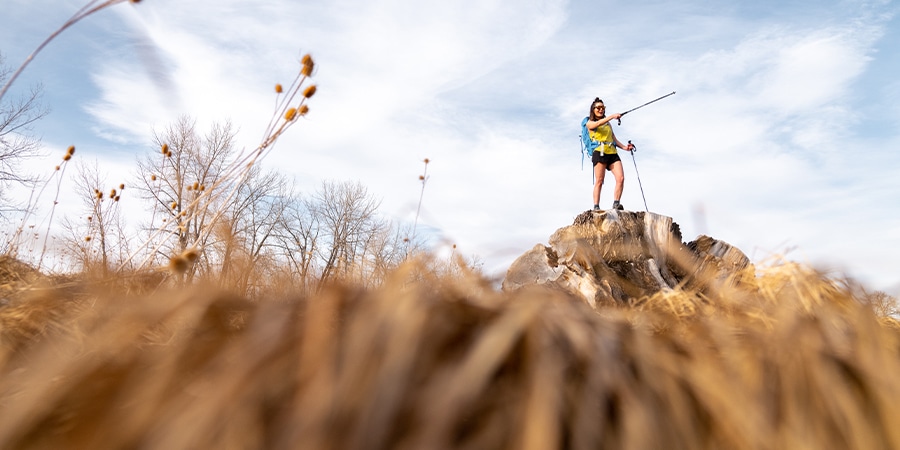
We asked more than 40 REI Co-op Members from around the country to hit the trails and to put our favorite hiking boots sold at REI through their paces. They hiked and hiked and hiked and hiked some more, tallying more than a thousand miles on their local paths and favorite backcountry routes. They literally scaled mountains, slogged through swamps, trekked across deserts and walked some dogs—all in the name of testing.
When all was said and done, each tester graded their sample boots on a 100-point scale for comfort, durability, traction, support, weight and price. The boots featured in this guide received the highest average scores in the test. Lowa Renegade Evo GTX Mid, Merrell Moab Speed 2 Mid GTX, On Cloudrock Mid Waterproof and Salomon X Ultra 5 scored the highest across our tester cohort.




![Mountain 600 Leaf GTX Hiking Boots - Men's [Left view]](/media/f9984328-ff7c-4e87-9b84-25bdebb982e0/?size=440)

![Mountain 600 Leaf GTX Hiking Boots - Men's [3/4 view]](/media/614ba669-6ea3-48bc-ae18-e8daf2b3f1b3/?size=440)













![Moab Speed 2 Mid GTX Hiking Boots - Men's [Left view]](/media/5128a845-c046-4bb6-bb4c-3762ea36a24b/?size=440)










